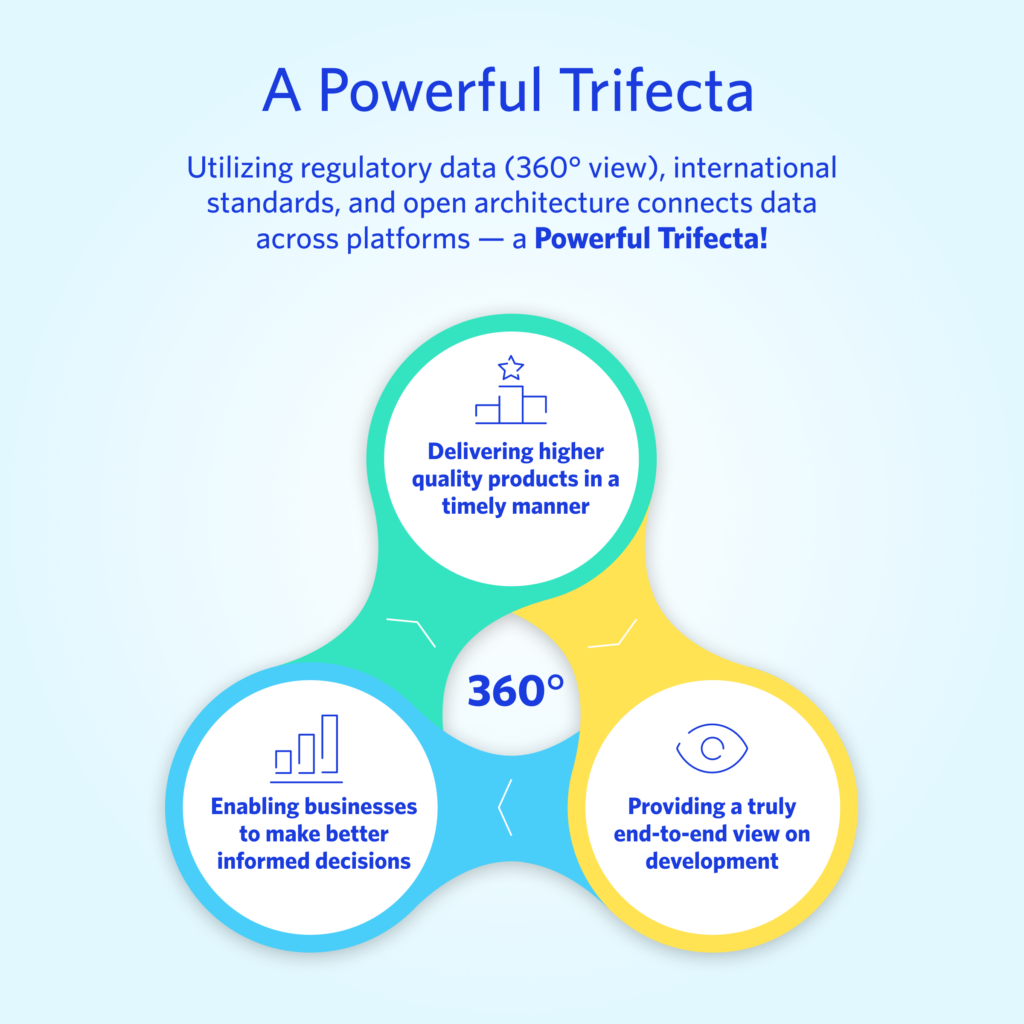Most regulatory information management (RIM) systems were designed to capture essential regulatory data elements, e.g., drug substance and drug product metadata, and to build compliant submissions, while recognizing the importance of connecting to publishing, document management and registration management as part of an end-to-end platform (E2E), with connected workflows, triggers, and notifications. However, with a greater emphasis on interlinking data and aligning to global standards, is an end-to-end regulatory platform enough? Should regulatory teams remain true to their core competency of building compliant submissions or use automated and interlinked data capabilities to expand their focus to include:
- Improving operational efficiency and effectiveness at both the global and local affiliate levels
- Enabling strategic decision making in every aspect of a life sciences organization
Are we moving from regulatory information management to regulatory data management?
It’s time for regulatory technologies, including RIM systems, to catch up to the evolving landscape. Instead of siloed systems meeting specific needs tied to specific regions, it’s time for an interconnected system based on global data standards that provides a comprehensive 360-degree view of the entire regulatory ecosystem to understand which drugs have quality issues, identify product shortages, and the therapies that require close monitoring monitor as they hit the market.
At this inflection point, organizations can now focus on data governance and data stewardship, which is required to properly maintain data that’s called upon for strategic decisions in the development lifecycle across safety, clinical, quality, or research and development and align to the format they require. Data governance at the dictates that data is role or attribute permission based so that the information can be trusted and utilized across the organization and thus, maintaining the integrity of this system. This system needs interconnection and fluidity providing a single source of truth, rather than copying and pasting from one to another, but it is this availability that can transform strategic decision-making across the organization.
Data connectivity is key to the evolution of the regulatory space. Utilizing modern technology to harmonize data globally and create a 360° solution that can quickly and accurately determine the safety and efficacy of therapeutics in the future.
Building a FAIR and Open Ecosystem
Data is only as useful as it is available. Where data was once locked inside a RIMS system and solely managed there, the volume of data created today makes it essential that the data must be findable, accessible, interoperable, and reusable. With the shift to global data standards and harmonized data exchange, openness and transparency are critical for both industry and regulators. To make accurate, financially viable decisions while ensuring patient safety, industry needs to be able to quickly access and assess the relevant data. Likewise, regulators need to be able to quickly access and review the relevant data to determine compliance with national and international standards. The quicker one has access to the data; the quicker one can ensure the drug is safe and effective. This principle of accessibility applies not only to traditional RIM data related to submissions, but also to quality, manufacturing, logistics, and commercial data.
It’s time to move from siloed data systems to open data systems that are strategically open and future ready. Structured data designed to only meet the needs of the national, regional, and functional standards to which they align leads to information that becomes siloed within the systems they are required to operate in. The lack of visibility across compliance with regions means that data is not being leveraged to its full potential – it’s locked within the proverbial black box. However, the principles of Findability, Accessibility, Interoperable and Reusable (FAIR) promote the transparency required for industry to graduate to a new regulatory paradigm. Published in 2016, the FAIR Guiding Principles for Scientific Data Management and Stewardship creates a useful architecture for data that utilizes minimal human intervention to provide data where and when it is needed. Here’s a breakdown of what that means for life sciences:
- Findable – data should have detailed metadata and identifiers to create a system where users can easily locate the information within the system
- Accessible – data should be understandable as well as the metadata and identifiers to both human and machine
- Interoperable – broad, understood language that is formalized and applicable to all areas where the data is used via agreed upon vocabulary
- Reusable – data works within its intended purpose based on its creation then continues throughout the system to provide additional and relative value
Utilizing a FAIR system, professionals can leverage technology to quickly call up strategic insights from their data, making it invaluable. Locking data away in a vault was never efficient and is now contributing to rising operational costs. Data must be easily accessible to create a true 360° view across the development lifecycle.
Establishing 360° Visibility
With a FAIR and open system, there can be a 360° view of the lifecycle. End-to-end is what we have today but it doesn’t supply a repeatable and full view that allows teams to leverage connected insights. This 360° visibility is especially critical for industry to make sound decisions on whether to continue development of a drug or how to manage a drug shortage or how best to manage a new solution. By drawing from the available regulatory data, product managers can proactively shape the future. Each business unit has a cross-functional view and access to validated regulatory data to support strategic decision making and operations whether it’s manufacturing, clinical, quality, or safety. As an example, connecting manufacturing with regulatory approvals expedites product availability and drives commercial success. With movement toward global product lifecycle management every aspect of a life sciences organization, from Regulatory Affairs to Finance and Regulatory Operations, that requires a 360° view is covered.
Unlocking the Powerful Trifecta

Industry can now create technology systems that provide the data they need to quickly and efficiently determine whether drug development should continue or what impact a marketing authorization delay will have on commercial activity. The system must be equipped to transmit compliant data to regulatory health authorities to meet their requirements, but also have the capacity to meet a life sciences organization’s additional needs for insights derived from the regulatory data. These additional capabilities will provide a more robust picture to authorities and begin to gain trust for global approvals among authorities, making industry a power player in developing national regulations.
Processes can evolve to allow the person responsible to enter the data in the system of record and designate it as the single source of truth. This data can then be used by others to meet their needs, whether predictive analysis, structured content authoring, or gaining regulatory approval. Each of these elements can provide transformational insights at the right time for organizations.
Want to learn more about why interconnectivity matters and how it can accelerate transformation? Watch this innovative Breakthrough session, The Value of Interconnected Data Across the Drug Development Lifecycle here.




